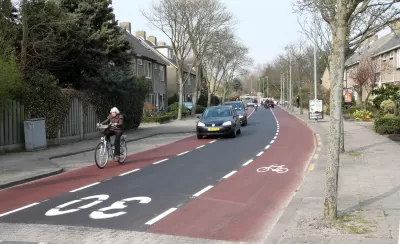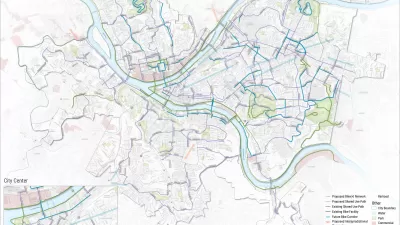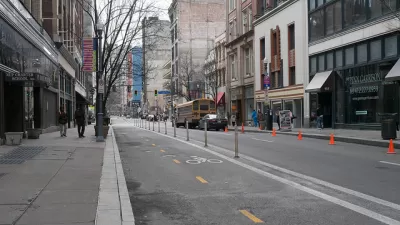The design uses a central traffic lane and adjacent two-way bike lanes to prioritize people on bikes on a popular cycling route.

A new “advisory bike lane” in Pittsburgh is the first of its kind in the city, reports Chris Hoffman for CBS Pittsburgh. Traffic lanes on a stretch of 18th Street were reduced from two to one central lane, with bike lanes on both sides. “For drivers coming toward each other, they will yield to any bicyclists, move into the bike lane, pass each other and continue on.”
Explaining the new layout, Bike PGH Advocacy Director Eric Boerer said “It's really no different than any other narrow street in Pittsburgh where you have two cars approaching and you have to negotiate passing each other safely.”
“According to Bike Pittsburgh, this street was a perfect fit for the change because it's in a park, has a lower speed limit and is predominately used by cyclists.” The 18th Street advisory lane is one step toward connecting Pittsburgh’s bike infrastructure into a cohesive grid.
FULL STORY: Pittsburgh adds first-of-its-kind advisory bike lane

Manufactured Crisis: Losing the Nation’s Largest Source of Unsubsidized Affordable Housing
Manufactured housing communities have long been an affordable housing option for millions of people living in the U.S., but that affordability is disappearing rapidly. How did we get here?

Americans May Be Stuck — But Why?
Americans are moving a lot less than they once did, and that is a problem. While Yoni Applebaum, in his highly-publicized article Stuck, gets the reasons badly wrong, it's still important to ask: why are we moving so much less than before?

Using Old Oil and Gas Wells for Green Energy Storage
Penn State researchers have found that repurposing abandoned oil and gas wells for geothermal-assisted compressed-air energy storage can boost efficiency, reduce environmental risks, and support clean energy and job transitions.

Updating LA’s Tree Rules Could Bring More Shade to Underserved Neighborhoods
A new USC study finds that relaxing Los Angeles’ outdated tree planting guidelines could significantly expand urban tree canopy and reduce shade disparities in lower-income neighborhoods, though infrastructure investments are also needed.

California's Canal Solar Projects Aim to Conserve Resources and Expand Clean Energy
California’s Project Nexus has begun generating electricity from solar panels installed over irrigation canals, with researchers and state agencies exploring statewide expansion to conserve water and boost clean energy production.

HHS Staff Cuts Gut Energy Assistance Program
The full staff of a federal program that distributes heating and cooling assistance for low-income families was laid off, jeopardizing the program’s operations.
Urban Design for Planners 1: Software Tools
This six-course series explores essential urban design concepts using open source software and equips planners with the tools they need to participate fully in the urban design process.
Planning for Universal Design
Learn the tools for implementing Universal Design in planning regulations.
Heyer Gruel & Associates PA
City of Moreno Valley
Institute for Housing and Urban Development Studies (IHS)
City of Grandview
Harvard GSD Executive Education
Salt Lake City
NYU Wagner Graduate School of Public Service
City of Cambridge, Maryland




























